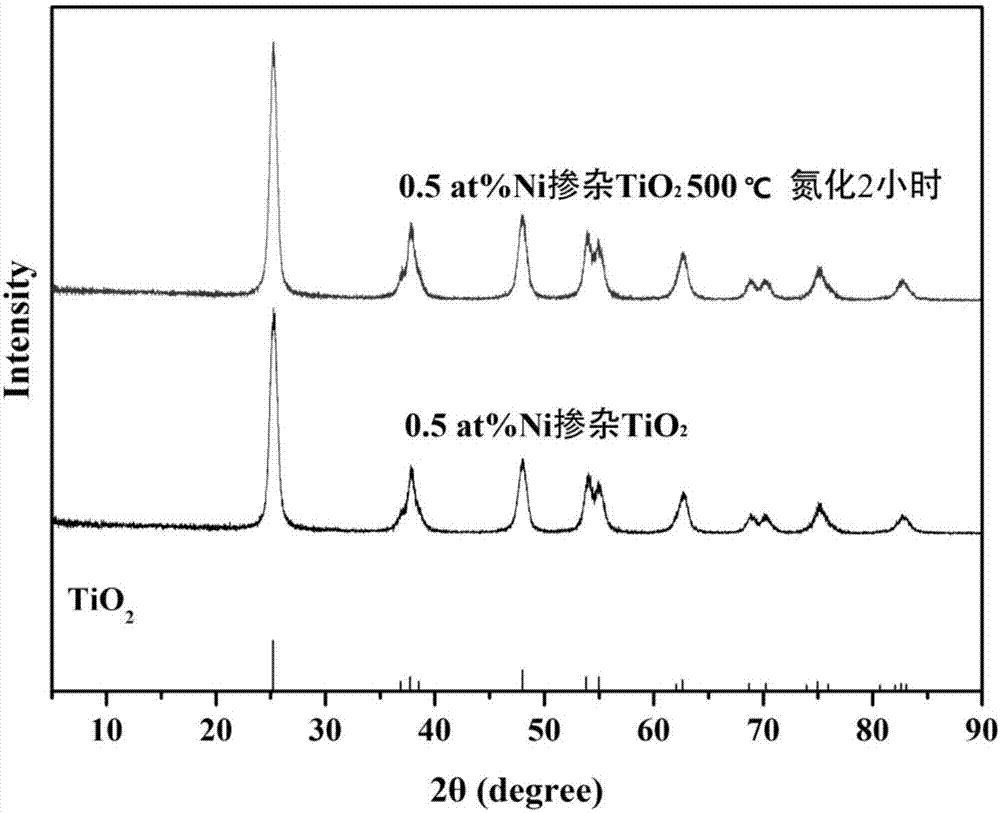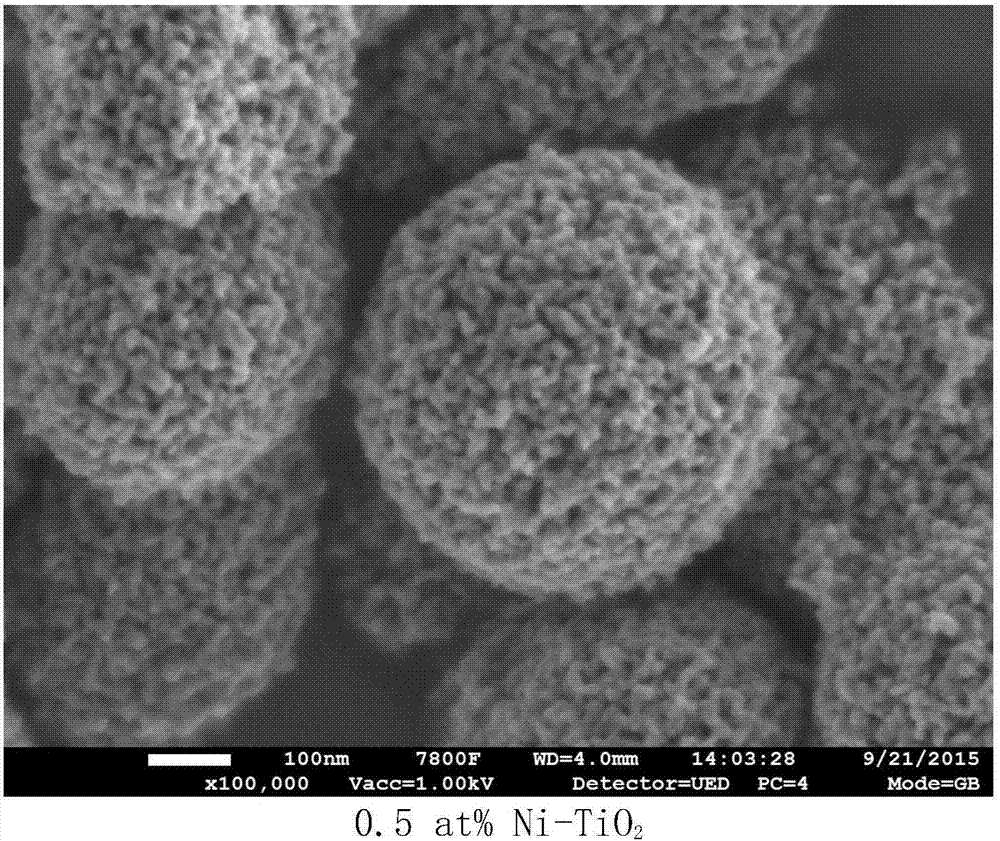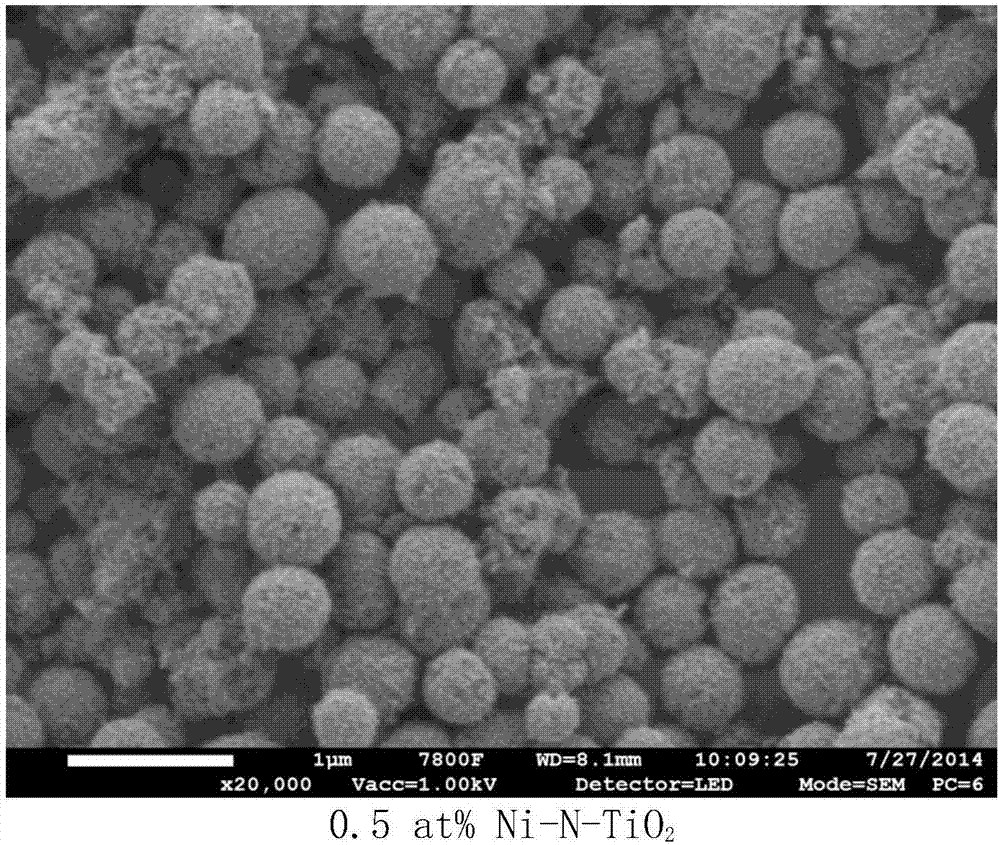Mesoporous surface defect Ni-N-TiO2 microsphere photocatalytic material and preparation method thereof
A technology of photocatalytic materials and defects, applied in chemical instruments and methods, physical/chemical process catalysts, chemical/physical processes, etc., can solve problems such as surface defects
- Summary
- Abstract
- Description
- Claims
- Application Information
AI Technical Summary
Problems solved by technology
Method used
Image
Examples
Embodiment 1
[0028] At room temperature, fully dissolve 1.98g hexadecylamine in 200mL ethanol solution (98wt.%), stir magnetically, add nickel sulfate solution, add 1.6mL deionized water at the same time, finally turn down the magnetic stirrer rotation speed, press Ni and The molar ratio of Ti is 0.5 / 100 and titanium isopropoxide is added rapidly. After stirring for 30s, the solution was left to settle for 18h. The resultant was washed 3 times with ethanol and deionized water, dried and ground. Transfer the powder to a 100mL stainless steel high temperature and high pressure reactor with polytetrafluoroethylene lining, add 40mL ethanol and 20mL water, place it in a muffle furnace for hydrothermal reaction at 160°C for 18h, then cool to room temperature, and the obtained product is water and absolute ethanol for three times to remove possible residual impurities, centrifugally filter, and vacuum-dry at 60°C. The dried product was calcined at 500° C. for 2 h in an air atmosphere. Mesoporo...
Embodiment 2
[0030] At room temperature, fully dissolve 1.98g hexadecylamine in 200mL ethanol solution (98wt.%), stir magnetically, add nickel sulfate solution, add 1.6mL deionized water at the same time, finally turn down the magnetic stirrer rotation speed, press Ni and The molar ratio of Ti is 0.1 / 100 and titanium isopropoxide is added rapidly. After stirring for 30s, the solution was allowed to settle for 12h. The resultant was washed 3 times with ethanol and deionized water, dried and ground. Transfer the powder to a 100mL stainless steel high temperature and high pressure reactor with polytetrafluoroethylene lining, add 40mL ethanol and 20mL water, place it in a muffle furnace for hydrothermal reaction at 180°C for 14h, then cool to room temperature, and the obtained product is water and absolute ethanol for three times to remove possible residual impurities, centrifugally filter, and vacuum-dry at 60°C. The dried product was calcined at 400 °C for 1 h in an air atmosphere. Calcin...
Embodiment 3
[0032] At room temperature, fully dissolve 1.98g hexadecylamine in 200mL ethanol solution (98wt.%), stir magnetically, add nickel sulfate solution, add 1.6mL deionized water at the same time, finally turn down the magnetic stirrer rotation speed, press Ni and The molar ratio of Ti is 0.2 / 100 and titanium isopropoxide is added rapidly. After stirring for 30s, the solution was allowed to settle for 12h. The resultant was washed 3 times with ethanol and deionized water, dried and ground. Transfer the powder to a 100mL stainless steel high temperature and high pressure reactor with polytetrafluoroethylene lining, add 45mL ethanol and 15mL water, place in a muffle furnace for hydrothermal reaction at 180°C for 14h, then cool to room temperature, and the obtained product is water and absolute ethanol for three times to remove possible residual impurities, centrifugally filter, and vacuum-dry at 60°C. The dried product was calcined at 400° C. for 30 min in an air atmosphere. Calci...
PUM
 Login to View More
Login to View More Abstract
Description
Claims
Application Information
 Login to View More
Login to View More - Generate Ideas
- Intellectual Property
- Life Sciences
- Materials
- Tech Scout
- Unparalleled Data Quality
- Higher Quality Content
- 60% Fewer Hallucinations
Browse by: Latest US Patents, China's latest patents, Technical Efficacy Thesaurus, Application Domain, Technology Topic, Popular Technical Reports.
© 2025 PatSnap. All rights reserved.Legal|Privacy policy|Modern Slavery Act Transparency Statement|Sitemap|About US| Contact US: help@patsnap.com



